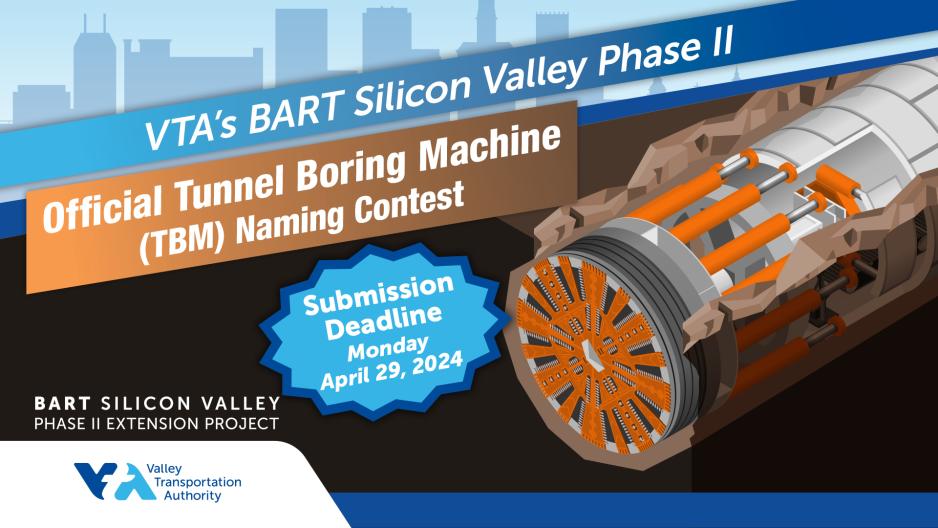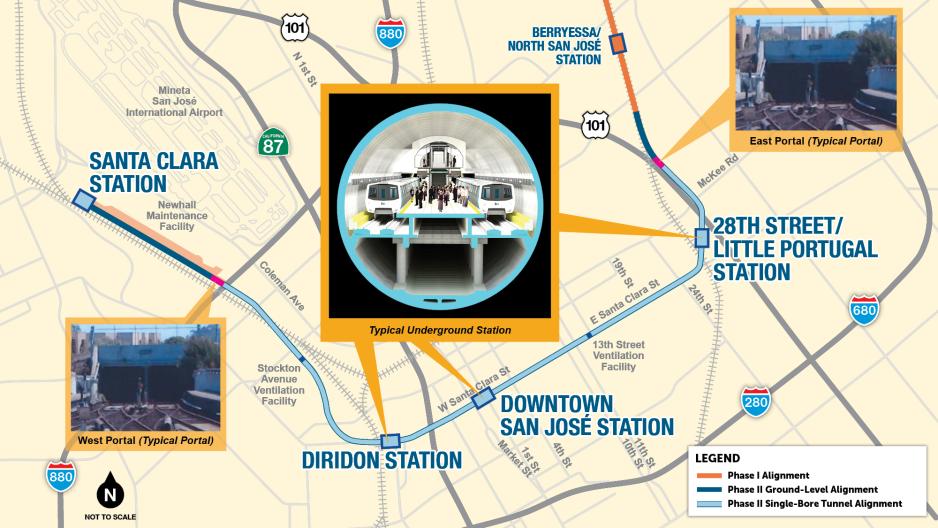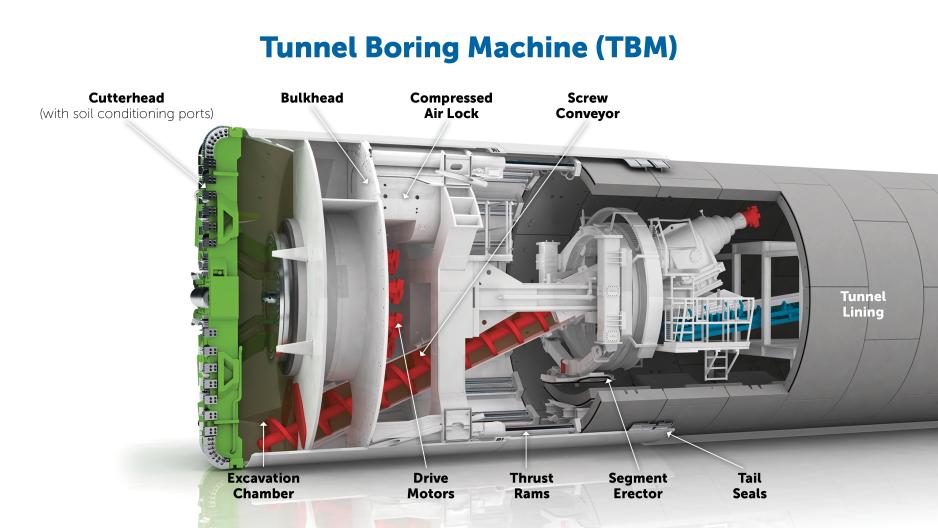Official Tunneling Boring Machine (TBM) Naming Competition
Join VTA in commemorating the spirit of innovation by submitting an entry to name the Tunnel Boring Machine (TBM) that will bore the five-mile tunnel portion of the project!
The tunnel boring machine for VTA’s BART Phase II Extension Project has been ordered and the custom built machine is expected to be delivered in 2025. It is a longtime tradition to name these massive machines. TBMs are traditionally given a female name to provide good luck to the project, and similar projects across the world have followed this practice. This tradition dates to the 14th century and is based on the patron saint of military engineers and miners, Saint Barbara, who stood as a symbol of protection and good luck for miners. Miners would name tunneling machines with a female name as a way to pay homage to her.
Naming a TBM after local female figures has also been a common practice among other transit agencies. For instance, San Francisco Municipal Transportation Agency (SFMTA) named the TBMs that constructed the Central Subway Mom Chung after Dr. Margaret Chung, the country’s first female Chinese-American physician and San Francisco resident, and Big Alma after Alma de Bretteville Spreckels, “The Great-Grandmother of San Francisco.”
VTA is seeking a name for the TBM that reflects the spirit of the Project and honors a prominent female figure (or a representative name) from, or associated with, Santa Clara County or the many local communities that surround the project area.
We invite you to submit your name for the official TBM naming contest, which will be open for six weeks starting Monday, March 18, 2024. All entries must be submitted online by 11:59 p.m. on Monday, April 29, 2024.
Take a look at the official contest flyer for more information!
The winner will receive a behind-the-scenes VIP tour for four individuals of the BART Silicon Valley Phase II Extension Project’s West Portal TBM construction launch site and more!
By submitting an entry, participants grant VTA permission to use their name and submitted entry for promotional purposes related to the project. Prizes have no cash value and cannot be traded, transferred, or sold. No purchase necessary. A selection committee made of VTA BSV Phase II staff and City of San José and City of Santa Clara staff will choose the winning submission. VTA reserves the right not to use any submission that falls outside of the naming criteria guidelines.
Contest Rules
- By submitting an entry, participants grant VTA permission to use their name and submitted entry for promotional purposes related to the project.
- If the same name is submitted by multiple people, the entry submitted first will be the one considered.
- Prizes have no cash value and cannot be traded, transferred, or sold.
- No purchase necessary.
- A selection committee made of VTA BSV Phase II staff and City of San José and City of Santa Clara staff will choose the winning submission.
- VTA reserves the right not to use any submission that falls outside of the naming criteria guidelines.
The Tunnel's Path
VTA’s BART Silicon Valley Phase II Extension Project includes the construction of a tunnel that will be approximately five-miles long. Tunnel construction will begin south of the Santa Clara Station within Newhall Yard and run underneath I-880 and the Caltrain tracks. It will be launched from what is referred to as the West Portal. From there, the tunnel will continue southeast and cross under the western side of the Caltrain tracks at Emory Street and then continue under Stockton Avenue and curve east before reaching Diridon Station. From Diridon Station, the tunnel will continue under Santa Clara Street for approximately one-mile to the future Downtown San José Station. It will then curve northeast near 27th Street and Santa Clara Street to the future 28th Street/Little Portugal Station. From there, the tunnel will continue northeast under US 101 to McKee Road where it will run parallel to the highway until it surfaces at the East Portal, near Las Plumas Avenue and Marburg Way.
Tunneling Construction
Construction of the subway tunnel is within the Tunnel and Trackwork contract (Contract Package 2). The tunnel will be constructed as a single, large diameter tunnel, commonly referred to as Single-Bore, and will contain two independent track ways, one for each direction of travel. The tunnel will be excavated by a Tunnel Boring Machine (TBM). The TBM is an electrically powered machine that removes soil, rocks, and debris to create the underground tunnel. It features a cutter-head, which rotates to dig through soil and rock. Excavated material is removed through a conveyor system within the machine. The TBM will be able to excavate and build approximately 30 to 40 feet of the tunnel per day on average. At the stations, mining techniques will be used to excavate the underground connections between the tunnel and stations (which contain the boarding platforms). Tunneling is expected to occur 24 hours a day, up to 7 days a week to excavate and support the five-mile tunnel.
How a Tunnel Boring Machine (TBM) Operates
A Tunnel Boring Machine (TBM) will remove soil from the tunnel itself, keeping the street above intact. The TBM includes a cutter-head, which rotates to dig through soil and rock. The excavated material will then be removed through a conveyor system within the machine. TBM boring speeds vary greatly, depending on the size and length of the tunnel, the geological conditions, and many other factors. The following video demonstrates how TBMs work.
Official Tunneling Boring Machine (TBM) Naming Competition
Join VTA in commemorating the spirit of innovation by submitting an entry to name the Tunnel Boring Machine (TBM) that will bore the five-mile tunnel portion of the project!
The tunnel boring machine for VTA’s BART Phase II Extension Project has been ordered and the custom built machine is expected to be delivered in 2025. It is a longtime tradition to name these massive machines. TBMs are traditionally given a female name to provide good luck to the project, and similar projects across the world have followed this practice. This tradition dates to the 14th century and is based on the patron saint of military engineers and miners, Saint Barbara, who stood as a symbol of protection and good luck for miners. Miners would name tunneling machines with a female name as a way to pay homage to her.
Naming a TBM after local female figures has also been a common practice among other transit agencies. For instance, San Francisco Municipal Transportation Agency (SFMTA) named the TBMs that constructed the Central Subway Mom Chung after Dr. Margaret Chung, the country’s first female Chinese-American physician and San Francisco resident, and Big Alma after Alma de Bretteville Spreckels, “The Great-Grandmother of San Francisco.”
VTA is seeking a name for the TBM that reflects the spirit of the Project and honors a prominent female figure (or a representative name) from, or associated with, Santa Clara County or the many local communities that surround the project area.
We invite you to submit your name for the official TBM naming contest, which will be open for six weeks starting Monday, March 18, 2024. All entries must be submitted online by 11:59 p.m. on Monday, April 29, 2024.
Take a look at the official contest flyer for more information!
The winner will receive a behind-the-scenes VIP tour for four individuals of the BART Silicon Valley Phase II Extension Project’s West Portal TBM construction launch site and more!
By submitting an entry, participants grant VTA permission to use their name and submitted entry for promotional purposes related to the project. Prizes have no cash value and cannot be traded, transferred, or sold. No purchase necessary. A selection committee made of VTA BSV Phase II staff and City of San José and City of Santa Clara staff will choose the winning submission. VTA reserves the right not to use any submission that falls outside of the naming criteria guidelines.
Contest Rules
- By submitting an entry, participants grant VTA permission to use their name and submitted entry for promotional purposes related to the project.
- If the same name is submitted by multiple people, the entry submitted first will be the one considered.
- Prizes have no cash value and cannot be traded, transferred, or sold.
- No purchase necessary.
- A selection committee made of VTA BSV Phase II staff and City of San José and City of Santa Clara staff will choose the winning submission.
- VTA reserves the right not to use any submission that falls outside of the naming criteria guidelines.
The Tunnel's Path
VTA’s BART Silicon Valley Phase II Extension Project includes the construction of a tunnel that will be approximately five-miles long. Tunnel construction will begin south of the Santa Clara Station within Newhall Yard and run underneath I-880 and the Caltrain tracks. It will be launched from what is referred to as the West Portal. From there, the tunnel will continue southeast and cross under the western side of the Caltrain tracks at Emory Street and then continue under Stockton Avenue and curve east before reaching Diridon Station. From Diridon Station, the tunnel will continue under Santa Clara Street for approximately one-mile to the future Downtown San José Station. It will then curve northeast near 27th Street and Santa Clara Street to the future 28th Street/Little Portugal Station. From there, the tunnel will continue northeast under US 101 to McKee Road where it will run parallel to the highway until it surfaces at the East Portal, near Las Plumas Avenue and Marburg Way.
Tunneling Construction
Construction of the subway tunnel is within the Tunnel and Trackwork contract (Contract Package 2). The tunnel will be constructed as a single, large diameter tunnel, commonly referred to as Single-Bore, and will contain two independent track ways, one for each direction of travel. The tunnel will be excavated by a Tunnel Boring Machine (TBM). The TBM is an electrically powered machine that removes soil, rocks, and debris to create the underground tunnel. It features a cutter-head, which rotates to dig through soil and rock. Excavated material is removed through a conveyor system within the machine. The TBM will be able to excavate and build approximately 30 to 40 feet of the tunnel per day on average. At the stations, mining techniques will be used to excavate the underground connections between the tunnel and stations (which contain the boarding platforms). Tunneling is expected to occur 24 hours a day, up to 7 days a week to excavate and support the five-mile tunnel.
How a Tunnel Boring Machine (TBM) Operates
A Tunnel Boring Machine (TBM) will remove soil from the tunnel itself, keeping the street above intact. The TBM includes a cutter-head, which rotates to dig through soil and rock. The excavated material will then be removed through a conveyor system within the machine. TBM boring speeds vary greatly, depending on the size and length of the tunnel, the geological conditions, and many other factors. The following video demonstrates how TBMs work.


